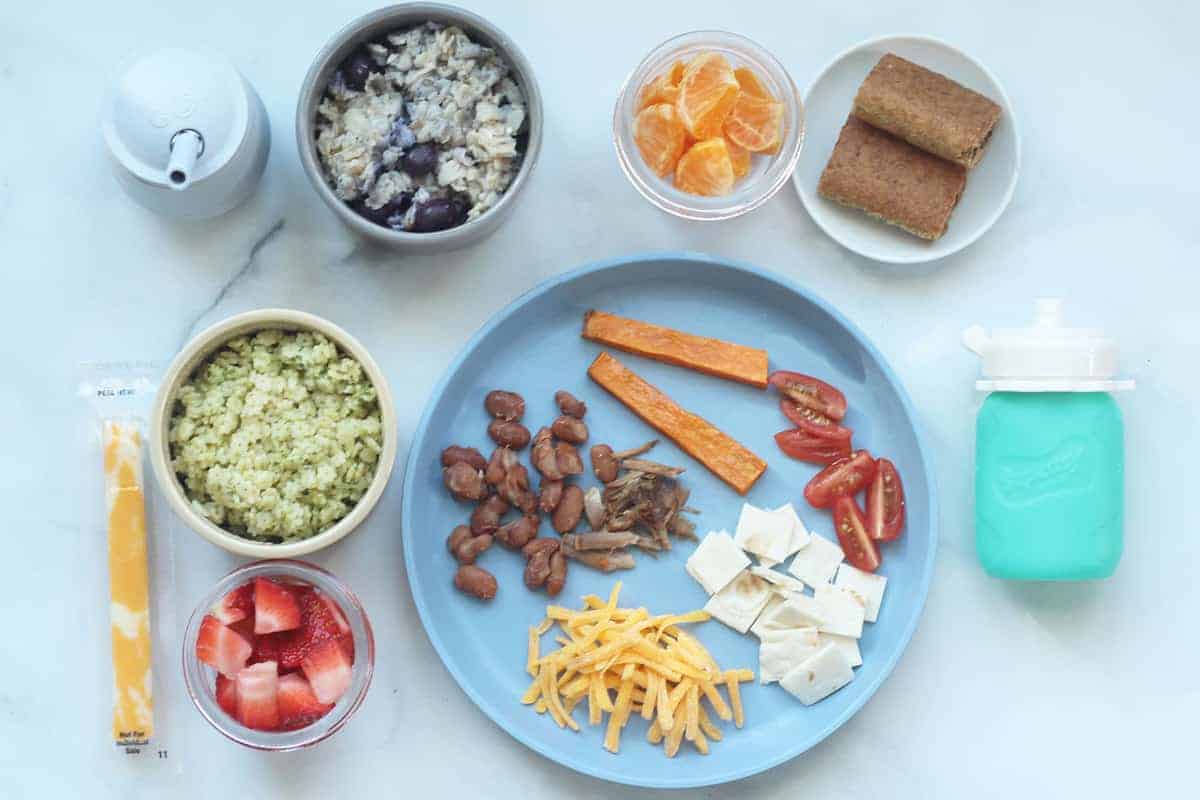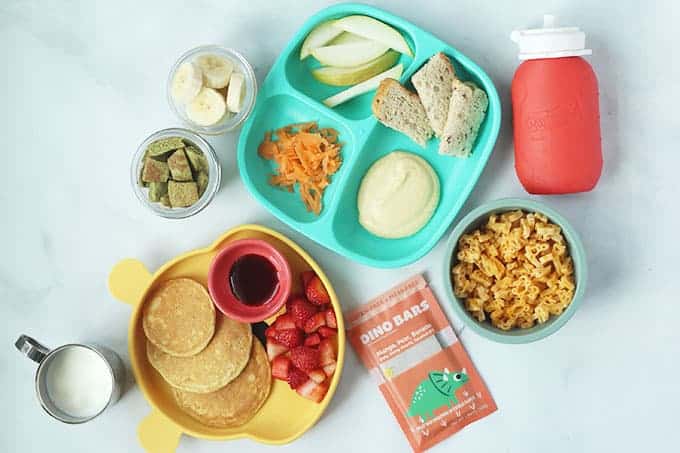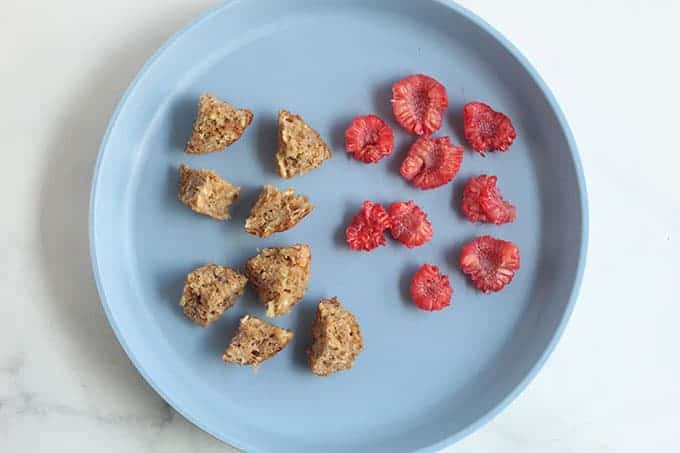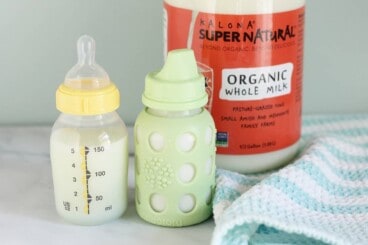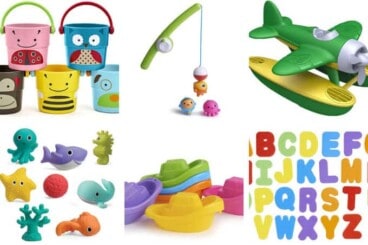One Year Old Feeding Schedule
Once a baby turns one and is eating meals and snacks, it can help to establish a routine to make it all easier on you to manage. Feeding kids is a lot of work and a basic feeding schedule is a great place to start. This is meant to offer guidance and to be adjusted for your reality, whatever that may look like, since I know that no two families have the same schedules or eating preferences.
Sample 1 Year Old Feeding Chart
I’m going to share three versions of a sample feeding charts to give you an idea of the time intervals between meals based on when the kiddo wakes up and goes to bed. Generally speaking, 2-3 hours between solid food is a good rule of thumb—though always remember that your child may be hungrier some days than others and may need that timeframe adjusted. Sign up for our email updates to get tips and ideas sent to your inbox.
Version 1
This example is for a toddler who’s taking milk in a sippy cup with meals (or drinks water with meals). Let’s assume wake up time is a little after 6 and bedtime is 7 pm. There may or may not be a morning nap, but there is an assumed afternoon nap from about 1-3 pm.
6:30 am: Breakfast 9 am: Snack 12 pm: Lunch 3 pm: Snack 5:30 pm Dinner
TIP: There could be a simple Bedtime Snack in the mix if needed before bed.
Version 2
This example is for a toddler who’s still drinking bottles and has water with meals. Let’s assume wake up time is 7 and bedtime is 8 pm. There may or may not be a morning nap, but there is an assumed afternoon nap from about 1-3 pm.
7 am: bottle 8 am: Breakfast 10 am: Snack 12 pm: Lunch 1 pm: bottle 4 pm: Snack 6 pm Dinner 7:30 pm: bottle
TIP: We want to wean kids from bottles by 2 at the latest, and the sooner you do it, the easier it often is. Work on transitioning the milk consumption to be with meals during the one year old year, rather than separate standalone bottles, especially if it seems to be limiting hunger for solids.
Version 3
This example is for a toddler who’s breastfed and has water with meals. Let’s assume wake up time is 6:30 am and bedtime is 7:30 pm. There may or may not be a morning nap, but there is an assumed afternoon nap from about 1-3 pm. There of course may be more nursing sessions in the mix here if the child is nursed on demand, so adjust as needed for your real life.
6:30 am: breastfeeding 7:30 am: Breakfast 9:30 am: Snack 12 pm: Lunch 1 pm: breastfeeding 4 pm: Snack 6 pm: Dinner 7 pm: breastfeeding
TIP: If the child doesn’t seem hungry for snacks, you don’t always have to do them. They may be full from the breastmilk and solids. If breast feeding seems to be limiting hunger for solids, you can consider tapering down the daytime sessions if you want. (No pressure, just know that some kids aren’t hungry enough for all meals and snacks and breastmilk during their one year old year so something could be adjusted if desired.
1 Year Old Meal Plan
I prefer to have a general framework for when meals happen because it helps me to plan the rest of the day. It also helps the kids to generally know what to expect and when, even if it’s as simple as learning that we go outside after morning snack and do our bedtime routine after dinner. TIP: Find a week’s worth of Sample Meals for Toddlers here.
Picky Eating in One Year Olds
I hear from a lot of parents with 14-19 month olds who are suddenly “picky” and aren’t interested in the food that they used to love as a baby. Here’s what to keep in mind if that describes your situation: It is very normal for one year olds to grow less rapidly than they did as babies, and to have a correspondingly lower appetite. It is very common for parents to see kids eating less and fewer foods and assume it’s “pickiness” when in fact the child is simply not as hungry as we expect them to be. Try serving smaller portions, spacing out meals or snacks a bit, and letting it be okay if the child eats less than you expect. Also developmentally, kids this age are exploring all of their boundaries—from the color of their socks to the fork they prefer to whether or not they want to walk on the sidewalk—so it’s normal to see some of this show up at the dinner table. This is not a sign that anything is necessarily wrong, but is it usually a normal part of the kids realizing they are independent from us, have the power to say “no” (and get a reaction), and voice their opinions. Remember: It’s not your job to “get” your child to eat. It’s your job to offer a variety of food that is tasty, easy for them to chew, and developmentally appropriate. It’s also our job to set the routine for when and where meals happen and what things are like during meals—we sit in our chairs, we don’t throw our food, etc. It’s their job to decide how much of the food to eat and which foods. If we expect these factors during toddlerhood, it’s much easier to empathize and understand why they are happening—and realize that our kids are doing the normal work of figuring out their world. TIP: Toddlers go through a normal phase called “neophobia” where they are naturally more skeptical of less familiar foods (or even foods they haven’t seen in a few days or weeks). Read up on that developmental stage so you can keep what you’re experiencing in perspective.
How do I know if my toddler is eating enough?
The general rule of thumb is to consider if the child is growing, gaining weight, and meeting milestones. Do they mostly seem happy? If the answers to all of those are yes, chances are very high that the kiddo is eating plenty. But, if your gut tell you that something is off or your pediatrician is concerned with growth (such as falling off of the child’s own unique growth curve), you may need additional help from your pediatrician or a feeding therapist. TIP: I recommend Thrive by Spectrum Pediatrics and Lutz, Alexander & Associates Nutrition Therapy for personalized feeding therapy. My ebook How to Relax about Picky Eating can help too.
Best Tips for Success
I’d love to hear your feedback on this post, so please comment below to share!
How to Wean a Toddler
10 Best Toddler Bath Toys
This post was first published on March 23, 2021.
